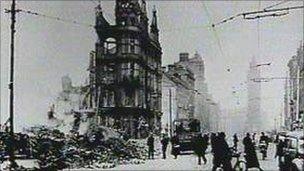Darkest days - Belfast remembers the Blitz
- Published

Belfast was ill-prepared for the blitz
It was one of Northern Ireland's darkest days - the Belfast Blitz.
15 April 1941 was a night when nearly 1,000 people were killed during a sustained bombing campaign by the Germans.
The city was regarded as a legitimate target during World War II because of its shipyard and aircraft factory.
The night chosen by the bombers to carry out their deadly attack was Easter Tuesday 1941.
An air warden in Belfast that night said "The sirens started at quarter to eleven, and by eleven o'clock my team was on the street - that started six hours of horror, death and destruction."
For hours, hundreds of tons of high explosive bombs and incendiaries rained down on the city.
Around the targets in the docks area were crowded terraced houses. Back-to-back streets of industrial squalor, the housing of those who worked in the factories and mills.
Any stray bomb would kill civilians in large numbers.
The dead were stacked in the emptied pool of the Falls Road public baths, and in a market near the city centre.
Many bodies and parts of bodies could not be identified - if there were rosary beads in a pocket, then the victim was likely to be a Catholic.
Not only was there a huge loss of life - but there was also extensive damage across Belfast.
Bombs hit half of the houses in the city, leaving 100,000 people homeless.
Memories of that night were etched clearly in the minds of survivors.
One Belfast man recalled putting out fires on the Antrim Road, Cavehill Road and York Street.
"Two of our comrades from the Sans Souci station were killed. They were coming along Royal Avenue when a bomb dropped and it left a crater. They drove into the crater."
But what he never forgot was going out after a bombing in York Street.
"I saw an Alsatian dog with a dead baby in its mouth. It was running away. I took off my metal helmet and threw it on the ground. The rattle scared the dog and he dropped the baby.
"I remember wrapping the baby's body in some old net curtain from one of the bombed houses.
"I left the baby with some soldiers, having attached a note to say that the body was found on York Street... Things like that, you never forget."

100,000 people were left homeless
He also remembered his friend, whose house in north Belfast was bombed, and who was never able to find his father and mother's bodies.
"We went down to the stalls in the market. The dead were laid out on them. And I remember going along and lifting the sheeting to look at the bodies. But we never found his parents."
There are two monuments now at the mass graves where the unidentified dead were buried - one in the Catholic Milltown Cemetery, the other in the non-denominational City Cemetery, both on the Falls Road.
No-one knows if the identifications were correct. Protestant and Catholic were united in death.
The blitz on Belfast is, in some ways, a forgotten episode of the war.
The lettering on the two monuments is faded and moss-filled.
Yet it united Protestant and Catholic in suffering - and fire brigades from the Irish Republic twice came north to help out, even though Eamon de Valera's Ireland was neutral.
BBC Newsline is marking the 70th anniversary of the Belfast Blitz with a series of special reports.
We would like to hear from people who can remember that night.
You can get in contact by emailing bbcnewsline@bbc.co.uk